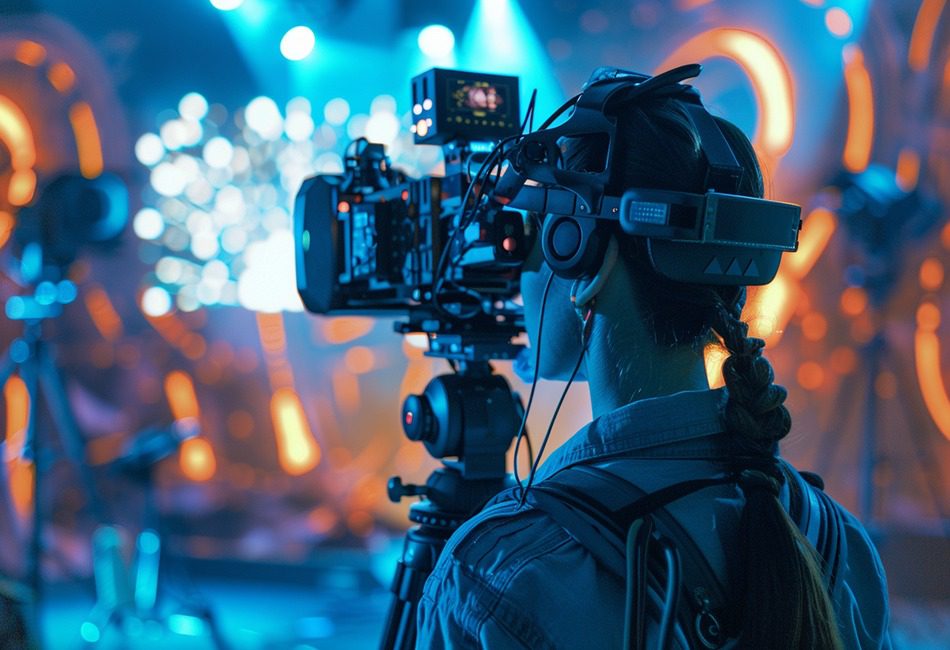A deep dive into the innovations, impacts and ethics of new film production technology in the world of location filmmaking
If you’re concerned about AI in filmmaking, we’re here to help you navigate the innovation in the industry. In this ever-evolving landscape, film production technology plays a pivotal role in shaping creative processes and enhancing production efficiency. We’re diving into how technology—specifically Artificial Intelligence (AI), Virtual Reality (VR) and Augmented Reality (AR)—is currently transforming the world of filmmaking. These innovations aren’t just buzzwords anymore; they’re fundamentally changing how movies are made, especially when it comes to scouting locations and enhancing overall production.
Be sure to Subscribe for FREE to Destination Film Guide and Download the Magazine for FREE to uncover more unique production content and expert resources.
How AI is Changing Filmmaking and Location Scouting
Let’s start with AI in filmmaking, specifically when location scouting. Traditionally, finding the perfect location involves extensive research, site visits and negotiations; this process is extraordinarily time-consuming. Imagine algorithms that can sift through heaps of data—like historical weather patterns, geographical details, and logistical considerations—to find the perfect filming spots. AI does just that. It saves filmmakers time and money by pinpointing locations that fit the script and production needs like a glove. Major studios like Warner Bros. and Netflix are already harnessing AI to streamline their scouting processes, ensuring every location enhances the story seamlessly.
Benefits of Virtual Reality (VR) in Location Scouting

Now, let’s step into the world of virtual reality (VR). This technology offers filmmakers a unique and immersive way to scout potential filming locations. With VR headsets, directors can walk through digital replicas of real-world settings, getting a feel for the atmosphere and scale without leaving their desks. It’s like being there without physically being there, which not only saves travel costs but also provides a more immersive scouting experience. Companies like The Third Floor and Technicolor are leading the charge by offering VR tools tailored for filmmakers, making location scouting more cost- and time-efficient. While VR hasn’t yet become popular amongst film studios, its potential for offering an engaging and immersive scouting experience is truly intriguing.
Augmented Reality (AR) Film Production Technology

Then there’s augmented reality (AR), which takes things a step further during actual filming. AR overlays digital elements onto real-world environments in real time. Picture directors adjust virtual sets or add digital creatures seamlessly into live-action scenes. Shows like “The Mandalorian” have used this film production technology extensively to create entire virtual worlds on set, enhancing both the visual impact and production efficiency.
Be sure to Subscribe for FREE to Destination Film Guide and Download the Magazine for FREE to uncover more unique production content and expert resources.
Integrating VR, AR and AI in Filmmaking

Now, here’s where it gets really exciting. When you combine VR, AR and AI in filmmaking, magic happens.
- AI helps analyze and choose locations
- VR lets you explore and scout locations virtually
- AR enhances what you can do on set
It’s a dream combo for filmmakers—boosting efficiency and overall production quality. From planning to shooting, these film production technologies streamline every step, allowing for more imaginative storytelling and pushing the boundaries of what’s possible in film.
Challenges and Considerations with AI in Filmmaking
Of course, adopting these new film production technologies isn’t without its challenges. One of the biggest concerns is ensuring these tools don’t overshadow the human touch and traditional filmmaking techniques. There is a risk of over-reliance on AI tools, potentially diminishing the role of human creativity and intuition in filmmaking. While AI, VR, and AR offer incredible benefits, they can also pose ethical dilemmas—like privacy concerns with AI data collection. Filmmakers need to strike a balance, leveraging technology while preserving the artistry and authenticity of their craft.
Will AI Take Our Jobs?

Janice Polley, the veteran location scout and manager behind numerous box office hits such as The Tenet, Heat, and Collateral, isn’t too concerned about the future of AI in film. “About eight years ago, everybody thought that with advancements in visual effects, nobody’s going to work again because they’re just going to go to a stage and everything will be visual effects. And there were a lot of visual effects movies, but I never stopped working. So, I’m not really worried about AI either because people still want realism.”
Looking to the Future: Utilizing New Film Production Technology
Industry professionals should stay updated with rapid technological advancements. Networking with tech experts, attending industry conferences and exploring emerging tools are crucial steps. Embracing a mindset of continuous learning and adaptation will keep filmmakers relevant and empower them to harness these technologies responsibly.
These innovative film production technologies aren’t just tools; they’re transformative forces that enable filmmakers to push boundaries and tell stories in unprecedented ways. As we look to the future, the integration of VR, AR and AI in filmmaking promises to continue revolutionizing the industry, blurring the lines between imagination and reality. By embracing these innovations thoughtfully and creatively, filmmakers can unlock new realms of cinematic expression and audience engagement.
Be sure to Subscribe for FREE to Destination Film Guide and Download the Magazine for FREE to uncover more unique production content and expert resources.
By Tinder Kiely


